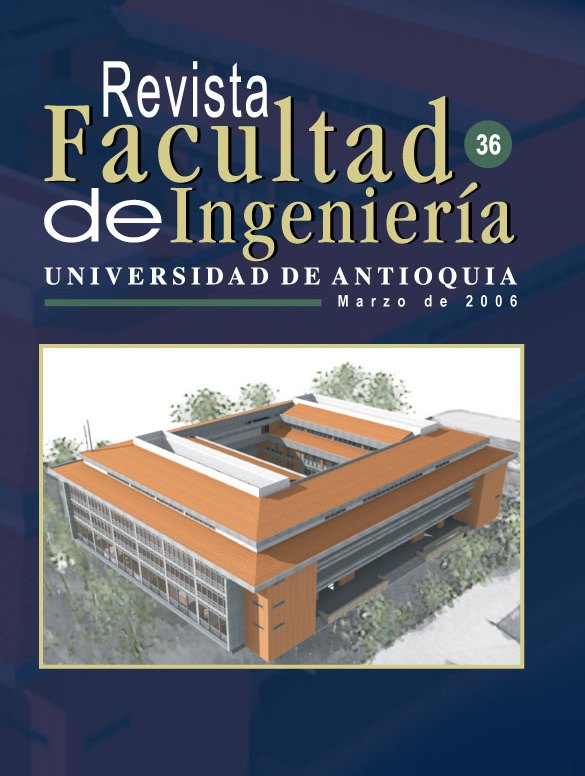Evaluación del impacto ambiental del proceso de obtención de alcohol carburante utilizando el algoritmo de reducción de residuos
DOI:
https://doi.org/10.17533/udea.redin.343247Palabras clave:
alcohol carburante, algoritmo WAR, evaluación de impacto ambientalResumen
En el presente trabajo se evalúa el desempeño ambiental de dos procesos para la obtención de etanol a partir de materias primas propias del país como el maíz y la caña de azúcar. Inicialmente se realizó la simulación de los procesos en el software comercial Aspen Plus. Obtenidos los balances de materia y energía de los procesos, se efectuó el análisis de impacto ambiental utilizando el algoritmo de reducción de residuos (algoritmo WAR), el cual evalúa la amigabilidad ambiental de un proceso. De los resultados obtenidos, el proceso a partir de maíz presenta un menor potencial de impacto ambiental de salida que el proceso a partir de caña de azúcar. Igualmente, la mayor generación de impacto ambiental en ambos procesos se da en la categoría de potencial de toxicidad acuática, debido principalmente a la elevada carga orgánica que involucran las vinazas producidas en este proceso.
Descargas
Citas
Ministerio de Minas y Energía. Ley 693 de 2001.
A. Acosta. El gran Desafío. Cali, 17 de junio de 2003. http://www.amylkaracosta.com/html/01-2003.htm. Consultada en junio de 2004.
Y. Yang, L. Shi. “Integrating environmental impact minimization into conceptual chemical process design: a process systems engineering review”. En: Computers and Chemical Engineering. Vol. 24. 2000. pp. 1409-1419. DOI: https://doi.org/10.1016/S0098-1354(00)00384-7
E. Heinzle, D. Weirich, F. Brogli, V. H. Hoffmann, G. Koller, M.A. Verduyn, K. Hungerbuhler. “Ecological and economical objective functions for screening in integrated development of fine chemical processes”. Industrial & Engineering Chemistry Research. Vol. 37. 1998. pp. 3395-3407. DOI: https://doi.org/10.1021/ie9708539
A. D. Elliott, B. Sowerby- B.D. Crittenden “Quantitative environmental impact analysis for clean design”. Computers Chem. Eng. Vol. 20. 1996. pp. 1377-1382. DOI: https://doi.org/10.1016/0098-1354(96)00236-0
A. H. Hilaly, S. K. Sikdar. “Pollution balance: a new methodology for minimizing waste production in manufacturing processes”. Journal of the Air & Waste Management Association. Vol. 44. 1994. pp. 1303-1308. DOI: https://doi.org/10.1080/10473289.1994.10467325
D. G. Young, H. Cabezas. “Designing sustainable process with simulation: the waste reduction (WAR) algorithm”. Computers and Chemical Engineering. Vol. 23. 1999. pp. 1477-1491. DOI: https://doi.org/10.1016/S0098-1354(99)00306-3
S. K. Mallick, H. Cabezas, J.C. Bare, S.K. Sikdar. “A Pollution Reduction Methodology for Chemical Process Simulators”. Ind. Eng. Chem. Res. Vol.35. 1996. pp. 4128-4138. DOI: https://doi.org/10.1021/ie9601108
S. K. Mallick, J.C. Bare. “Pollution prevention with chemical process simulators: the generalized waste reduction (WAR) algorithm-full version”. Computers and Chemical Engineering. Vol. 23. 1999. pp. 623-634. DOI: https://doi.org/10.1016/S0098-1354(98)00298-1
C. A. Cardona, V. F. Marulanda, D. Young. “Analysis of the environmental impact of butylacetate process through the WAR algorithm”. Chemical Engineering Science. Vol.59. No.24. 2004 pp. 5.839 – 5.845. DOI: https://doi.org/10.1016/j.ces.2004.06.043
Tutorial Software WAR GUI.
C. A. Cardona, O. J. Sánchez, “Analysis of fuel ethanol production processes using lignocellulosic biomass and starch as feedstocks”. 7th World Congress of Chemical Engineering, July 10-14 2005. Glasgow, Scotland, UK (Accepted for presentation).
A. Wheals et al. “Fuel ethanol after 25 years”. TIBTECH Vol. 17. 1999. pp. 482-487. DOI: https://doi.org/10.1016/S0167-7799(99)01384-0
M. I. Montoya, J. A. Quintero. Esquema tecnológico integral de la producción de bioetanol carburante. Trabajo de grado Universidad Nacional de Colombia, Manizales 2005. pp. 71-96.
Merrick & Company. Wastewater Treatment Options for the Biomass-To-Ethanol Process; NREL Subcontract AXE-8-18020-01, Final Report, Aurora, CO, 10/20/98.
The Sugar Sector Environmental Report. Environmental Technology Program for industry. 2003. http://www.cpp.org.pk/etpirpt/SugarSectorReport.pdf. Consultada en enero de 2004.
Renewable Fuels Association. Homegrown for the homeland. Ethanol Industry Outlook 2005. http://www.ethanolrfa.org/outlook2005. Consultada en febrero de 2005.
A. Mcaloon, F. Taylor, W. Yee, K. Ibsen, R. Wooley. Determining the Cost of Producing Ethanol from Corn Starch and Lignocellulosic Feedstocks. National Renewable Energy Laboratory Biotechnology Center for Fuels and Chemicals October 2000. NREL/TP580-28893. DOI: https://doi.org/10.2172/766198
X. Li., A. Kraslawski. “Conceptual process synthesis: past and current trends”. Chemical Engineering and Processing. Vol. 43. 2004 pp. 589-600. DOI: https://doi.org/10.1016/j.cep.2003.05.002
D. Young, H. Cabezas. Sustainability in Chemical Manufacturing Processes: WAR algorithm. U.S. Environmental Protection Agency. 26 W. Martin Luther King Dr. Cincinnati, Ohio 42268, USA. pp. 1-36.
Descargas
Publicado
Cómo citar
Número
Sección
Licencia
Los artículos disponibles en la Revista Facultad de Ingeniería, Universidad de Antioquia están bajo la licencia Creative Commons Attribution BY-NC-SA 4.0.
Eres libre de:
Compartir — copiar y redistribuir el material en cualquier medio o formato
Adaptar : remezclar, transformar y construir sobre el material.
Bajo los siguientes términos:
Reconocimiento : debe otorgar el crédito correspondiente , proporcionar un enlace a la licencia e indicar si se realizaron cambios . Puede hacerlo de cualquier manera razonable, pero no de ninguna manera que sugiera que el licenciante lo respalda a usted o su uso.
No comercial : no puede utilizar el material con fines comerciales .
Compartir igual : si remezcla, transforma o construye a partir del material, debe distribuir sus contribuciones bajo la misma licencia que el original.
El material publicado por la revista puede ser distribuido, copiado y exhibido por terceros si se dan los respectivos créditos a la revista, sin ningún costo. No se puede obtener ningún beneficio comercial y las obras derivadas tienen que estar bajo los mismos términos de licencia que el trabajo original.










 Twitter
Twitter